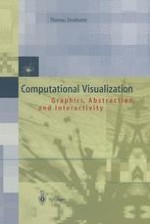1998 | OriginalPaper | Buchkapitel
Tactile Maps for Blind People
verfasst von : Prof. Dr. Thomas Strothotte
Erschienen in: Computational Visualization
Verlag: Springer Berlin Heidelberg
Enthalten in: Professional Book Archive
Aktivieren Sie unsere intelligente Suche, um passende Fachinhalte oder Patente zu finden.
Wählen Sie Textabschnitte aus um mit Künstlicher Intelligenz passenden Patente zu finden. powered by
Markieren Sie Textabschnitte, um KI-gestützt weitere passende Inhalte zu finden. powered by
Like maps for sighted people, tactile maps are depictions of areas like countries or towns. However, they are not just embossed versions of the maps that sighted people are used to (see Fig. 20.1). A number of particularities have to be observed to ensure the tactual legibility of these maps, resulting in several restrictions to the map design (refer to [Edm91] and [Hud83] for more information). Since haptic perception has a lower discriminability, symbols have to be larger and simpler, e.g., point symbols should have a diameter of 3–5 mm. To avoid confusion, symbols must have a minimum distance between one another. While these distances are about 0.1mm for visual features, tactile symbols must be at least 2–3 mm apart to ensure their separate perception. Braille texts have a fixed height of 6 mm and hence entail a street width of at least 8 mm to allow labeling of the streets. While color can be replaced by textures, the textured areas have to be very large to enable the differentiation of the different textures, and still there are only very few different textures easily recognizable even for larger areas.
